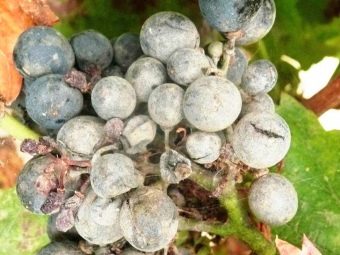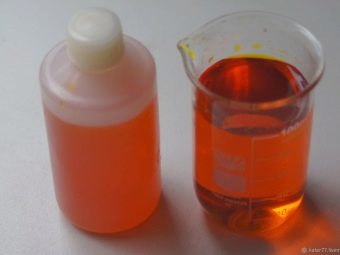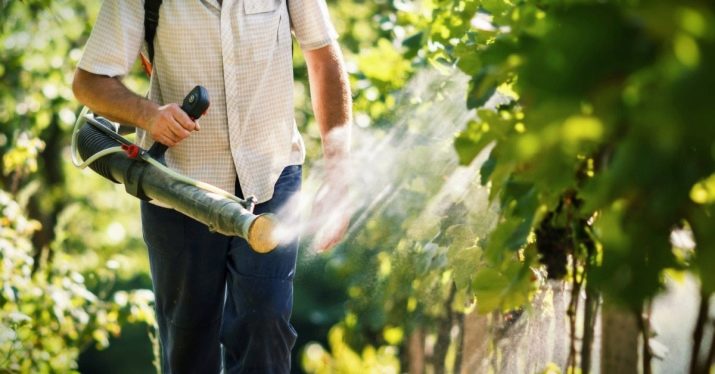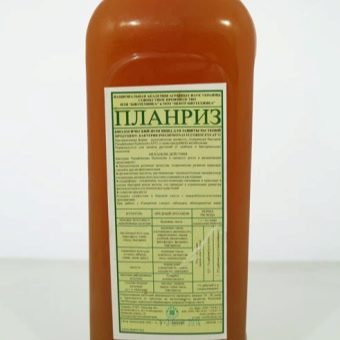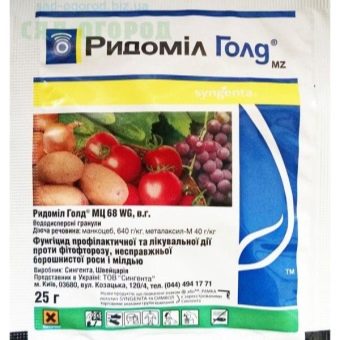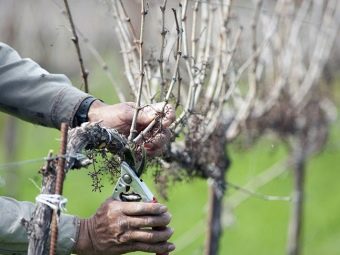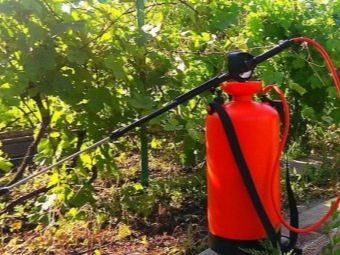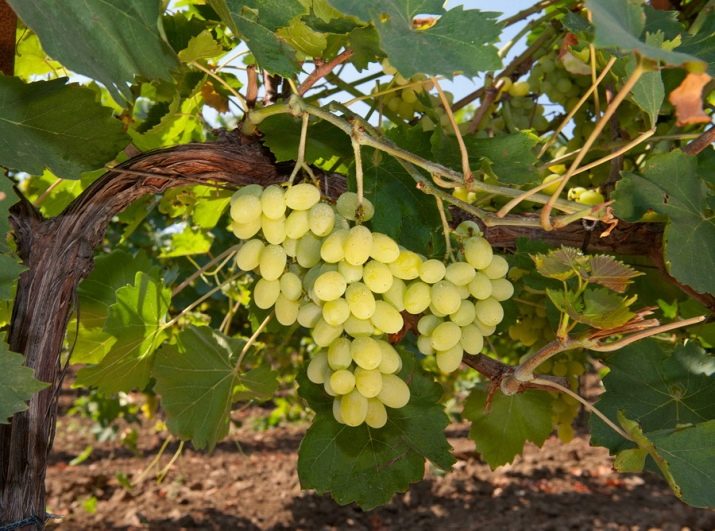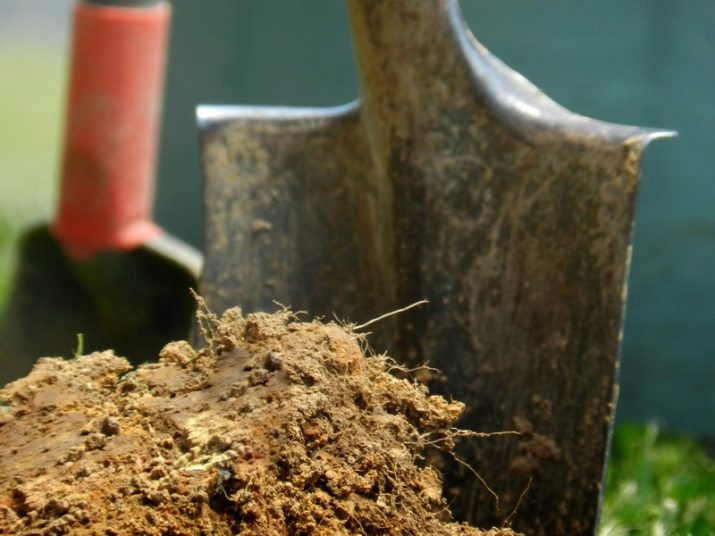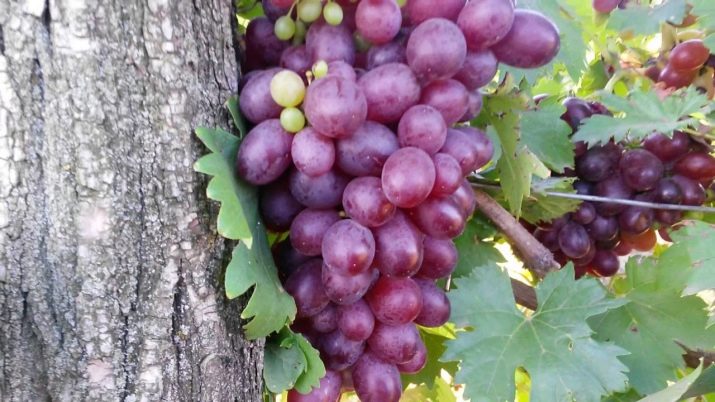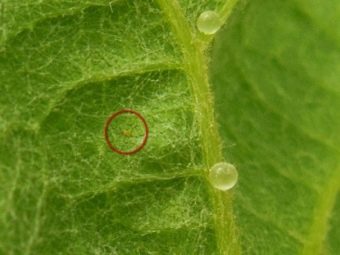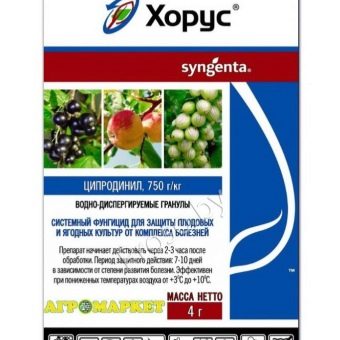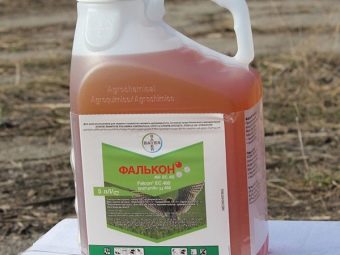How to process grapes?

Although grape care seems fairly easy, many gardeners face processing problems. This plant is distinguished by its tenderness and extreme sensitivity to various changes - be it the weather or harmful organisms. In order to protect the plant from pests, treatment is arranged at the very beginning of spring.
What is it for?
As you know, grape varieties, distinguished by their excellent taste - the most vulnerable varieties. They are very susceptible to fungi, as well as other various diseases. It is worth noting that infection can occur even if the owner has an agricultural technician.
The weather is also a big threat, especially one that often changes. If after heavy rain comes unbearable heat, the chances of infection increase significantly. With such drastic changes an environment favorable for the development of parasites is formed.
However, having carried out the necessary treatment at the right time, the gardener reliably protects his garden from fungi and other parasites, and he will not need to treat the diseased plant. But before processing it is necessary to carefully study the plant, and understand what you have to deal with.
List of diseases of culture
Grapes - a plant that needs little human care, because it takes its strength from the sun and the soil. However, by becoming sick, the grape becomes extremely vulnerable, and then it cannot do without human help.
Diseases of this culture, there are a huge variety. But knowing the basic symptoms and methods of treatment, the gardener is able to cure the plant.
There are only two types of grape diseases: infectious and non-infectious.
If we talk about infectious diseases, then it should be understood that diseases related to this type are associated with infections that pass from one plant to another. This type is treatable, but it will be very difficult to do.
Infectious diseases include fungi, and bacterial lesions, and viral diseases.
Fungal diseases
Mildew
Mildew is a dangerous fungus that can destroy the entire crop. It is very harmful, and its reproduction rate is extremely high, which causes the gardener not to hesitate, but to start treatment right away. However, today there are fungicidal treatments that can protect even the most vulnerable varieties.
There are a number of signs characteristic of mildew.
- On the leaves appear yellow or brown spots resembling oil. If it is a foliage of a young plant, then the spots are very small, not more than a penny, but on the old plant they are huge, oblong, and grow directly along the veins.
- On the back of the sheet appears white fluff - mycelium.
- After some time, the plant begins to curl.
- Fruits are painted in an unpleasant yellow color.
- Brushes noticeably darken.
- Those grapes that have outgrown the “pea” are painted blue and superficially resemble a blown-down ball.
This fungus came from Europe, and to this day is an extremely harmful disease. Its spores overwinter in the soil, and they fall on the plant with sprays that appear as a result of raindrops hitting the ground. They can also be transmitted by wind.
After the dispute gets on the sheet, it takes about four days, but on condition that the temperature is +24 degrees or more. Infection can be avoided by taking preventive measures. But to cure this disease is a very difficult thing, since it is incredibly resistant to all methods of struggle.
To heal the plant, you need to spray the soil under the vine, and this must be done before the first rain in spring, and after the vines are tied up. For tillage use "Nitrofen", namely: 400 grams. The substance is diluted in a ten-liter bucket filled with water.
Having treated the ground with this solution, it is necessary to mulch it. Mulching helps protect the space between the vine and the fungus in the soil, and also makes the blows of rain drops softer.
Further, the treatment itself takes place, namely: spraying the leaves with a fungicide. This will help save the ovary from mildew before they mature. But in order not to reach treatment, you can protect the grapes. This is usually done in the fall - they burn the foliage that the fungus has reached.
You can also spray the soil. For this, either iron or copper sulphate is used. Make them according to the instructions. These vitriol greatly slow the development of the disease. They are used after loosening the soil under the grapes. Processing takes place as follows: first, on the very first leaves, then on non-flowering brushes. Before this, it is necessary to remove excess leaves that will interfere.
In the case when the spraying will be problematic - plant seedlings with the existing immunity to mildew. If mildew appears on the neighboring site - you must also carry out preventive work, as disputes can bring wind.
Copper sulfates can be replaced by "Ditan M-45" or "Polycarbacin." Replacement occurs if the plants are more sensitive to copper. When heavy rains should increase the number of treatments three to four times. Processing is stopped a month before the crop ripens.
Vulnerable mildew varieties:
- "Cardinal";
- "Karaburnu";
- "Special";
- Rizamat;
- "Early Magaracha";
- "Iranian Shahin".
Oidium
This is a very common infectious disease, also known as powdery mildew. It initially affects only the berries, then goes to the leaves, then to the stems and to the bush itself.
Signs of plant mildew infection:
- appearance on the leaves of dirty gray plaque;
- the appearance of the same raid on the berries;
- the berries begin to crack, and their seeds go out;
- fruits get a very sour taste, as well as specific scars;
- bush covered with dirty bloom;
- leaves curl;
- fruits dry up;
- also the bush as a whole differs in the unpleasant smell reminding rot.
It is worth noting that only unformed young plants are susceptible to oidium, but the plants that have matured are protected.
This disease became famous in the middle of the XIX century. He was brought to Europe from North America. The fungus winters right in the body of the plant - in its kidneys or sprouts. Often it is found on fallen autumn leaves. This is the reason for thorough cleaning of such garbage before winter.
In the spring, spores of the pest, conidia, are formed. They carry the same way as other disputes - with the help of the wind. Having infected, the plant practically does not give any signals, it grows in the same way as it grew. Begin the alarm at the moment when the dew appears. To develop the disease, high humidity is not necessary.
Control measures consist mainly in the correct planting of bushes, increased attention to gusts of wind. Also requires good care of the soil, tracking weeds, thinning bushes, providing them with light.
But if the plant is already infected with oidium, then chemical treatment is used here, namely: two-percent lime-sulfur decoction. It is important to remember about safety. Effective as well "Fundazol", or, for example, "Bayleton".
There is another way. It also consists in chemical treatment, but with colloidal sulfur or sulfur powder. If the temperature is higher than 25 degrees, instead of spraying, dusting is carried out with the same sulfur, but only ground. It is important not to forget about the regularity of the procedures, since the effect of sulfur treatment lasts only ten days.
If treatment is stopped, the fungus will create new spores, and the disease will gain a new turn. Do this procedure preferably every one and a half or two weeks. However, if there is increased humidity or rain, then chemical work should be repeated. The sulfur used should be dry and milled. Harvesting can be carried out only 57 days after the last chemical work.
In addition to the above methods, many also use such folk remedies as baking soda. To do this, you need to take a ten-liter bucket of water, fifty grams of soda and forty grams of soap. The resulting solution has no side effects, and is also safe for children and the plants themselves.
If you do not want to engage in the treatment of plants, you can prevent infection with oidium. The most important condition for prevention is fresh air and soil aeration, as well as the right place for planting. Moisture in the infection does not play a role, since the disease is transmitted exclusively by the wind.
The peak of oidium development occurs on warm days when the air temperature is 25 degrees and above.
European varieties are most vulnerable, namely:
- "Cardinal";
- Chardonnay;
- "Rkatsiteli";
- Merlot;
- Cabernet Sauvignon.
Alternaria
This infectious disease creates spots and necrosis on the leaves of the vine, as well as berries and cuttings. Alternaria is settled, mainly on already weakened plants located in regions with hot and humid climates.
The main features are:
- the appearance of light spots on the leaves or shoots;
- leaf drying;
- the appearance of light shine on the berries;
- appearance on the berries of dirty gray plaque;
- wrinkling berries and their unpleasant taste.
Pest spores overwinter in the bark or in plant debris.
Symptoms become clear and clear in the second half of the growing season, however, treatment with chemicals should be carried out in early spring. Apply drugs such as "Ditan M-45", "VDG", "Skor", "Kvadris" and others. Processing takes place every 12 days.
Anthracnose
It occurs mainly in warm and humid regions. Pretty dangerous disease. The most vulnerable are those varieties that are resistant to diseases such as mildew and oidium. All parts of the plant are affected.
The main features include:
- leaf damage - small black dots form on them, which later become larger;
- the appearance of the same spots on the shoots;
- drying leaves;
- the appearance on the shoots of long brown spots;
- cracks in some places;
- drying and breaking of shoots;
- the appearance of round brown spots on the berries.
The worst thing about the disease is that it spreads unusually quickly, and subsequently destroys about 70 percent of the crop. To cure a plant, sick with anthracnose, it is extremely difficult. Its pathogens can stay on the plant for several years and not give any form. However, when the humidity of the air becomes higher and the temperature reaches 35 degrees, the disease progresses.
The beginning also happens due to acidic soil, improper pruning of a plant, hail and many other factors. Immediately after infection, the disease is transferred to other plants and harms them. It spreads through wind, rain and often with garden tools.
If the disease is still overtaken, the affected leaves and shoots must be immediately cut and burned, and then the grapes are processed. For processing using a solution Bordeaux mixture. And they start it only when the length of the shoots is ten centimeters and above.
After two weeks, the procedure is repeated. The drug should fall on the lower side of the sheet and not drain. Better time for chemical processing - early morning or late evening. Spraying with copper sulfate, which is carried out two weeks after the first chemical treatment, will not interfere either.
In the case when the disease has taken an extremely severe form, and preparations for treatment do not help, use systemic fungicides. It can be "Fundazol", "Ridomil", "Kartotsid", "Abiga-Peak" and some others. It may also be the latest biological products - "Gaupsin" or "Planriz". Processing is carried out regularly, every two weeks, and watering is reduced.
So how to deal with anthracnose is extremely difficult - prevention is necessary. Prevention consists of proper care, pruning, and stading. All garden tools should be treated with a solution of potassium permanganate, and then they should be treated with the plant itself.
Before flowering, the plant is sprayed with copper oxychloride. This should be done several times, and the interval between repetitions is two weeks.
We should not forget about pruning grapes. If it is carried out in the fall, then all removed leaves and shoots are burned.
The soil needs to be loosened, watered and mulched. It also benefits from various fertilizers and weed control.
The most vulnerable varieties are:
- "Muromets";
- "Isabel";
- "Viorica";
- Lydia;
- Vierul;
- "Danko".
Botrinosis
Botrinosis is a disease in which a kind of rot appears on the plant. It is extremely dangerous for the harvest, and getting rid of it is a difficult task.
Each individual type of rot manifests itself in different ways. If it is gray and white rot, then they occur only on ripe berries. White fur appears on the berries. If it is a black rot, then only small tubercles on the leaves are initially formed. The disease progresses during plant ripening.
Grape rot is divided into white, black and gray.
- White rot. Here infection occurs with a specific type of fungus.
Key features:
- the appearance on the berries of small yellow spots;
- drying berries;
- the acquisition of red color in spots;
- Leaf drying.
The most common infection occurs through damaged grapes.
- Black rot Spores of this fungus spend the winter on the vine. However, when the shoots begin to grow actively, the infection begins.
Key features:
- the appearance of brown spots on the leaves;
- berries acquire dark depressions;
- wrinkling, and then drying the berries.
- Gray rot. A disease that affects not only grapes, but also other plants. It is very dangerous, and can destroy the affected plant.
Key features:
- leaves acquire small dark spots;
- leaves are drying;
- cover gray shoots mold;
- fast drying and death of inflorescences;
- the appearance of purple spots on the berries.
In addition to the above types, there are also others, but these are the most basic and common.
The causes of the occurrence are fungi wintering in the bark and fallen leaves. In the winter the wintering stops, and the shoots are affected. Rot is spreading on sunburn and damaged areas. At high temperatures, the rate of development increases. In case of illness, treatment and cleaning of infected shoots and clusters is carried out.
For gray rot, there is a popular way of fighting. Diseased parts of the plant are cut and burned, and then the plant is sprayed with a solution of baking soda. This solution requires 70 grams of soda and one bucket filled with water. Such treatment is carried out regularly, with an interval of two weeks.
White rot can be fought in the same way as sulfur. Many also use drugs for mildew or oidium.
For black rot used a mixture of fungicides. You must have 25 grams of Ridomil Gold and 60 grams of Tiovit Jet, as well as a bucket of water. Processing is carried out several times, with an interval of two weeks.
Treatment of botrinosis is long and problematic, therefore it is impossible to prevent infection.
Prevention is needed:
- before covering the grapes for the winter, it is necessary to loosen the soil, and burn the distant and fallen parts of the plants;
- in early spring, spraying is carried out with Bordeaux mixture;
- requires proper pruning;
- do not conduct nitrogen supplements;
- also need competent watering.
Varieties vulnerable to gray mold:
- Terbash;
- "Dove";
- "Pearls Saba";
- "Karaburnu";
- "Riesling Rhine";
- "Rusbol";
- "Muscat Tairovsky."
Varieties vulnerable to black rot:
- "Italy";
- "The White Mask";
- "Queen of the vineyards";
- "Muscat Hungarian."
Varieties vulnerable to white rot:
- Alimshak;
- Aligote;
- "Riesling Rhine";
- "Swim."
Of course, that fungal diseases do not end there. There are a lot of them, but these descriptions are the most common.
Bacterial lesions
Bacteriosis
This disease develops on the background of depleted soil, drought, irregular pruning, lack of support, and so on. A significant role is also played here by some insects that bring harm.
Bacteriosis is divided into several types.
- Bacterial necrosis. With this disease, the lower part of the bush suffers.
Key features:
- black spots on the leaves;
- the appearance of darkened flowers on the inflorescences;
- shrunken shoots.
Bordeaux liquid helps to combat this problem, as well as the uprooting of infected bushes. The cause is often a deficiency of potassium in the soil, as well as toxic gases.
- Bacteriosis of berries. The disease affects individual berries, and occurs in very hot and sunny weather.
Key features:
- the formation of a yellow spot on the berry;
- the stain is pulled over the entire area of the berry and becomes purple;
- the berries dry out.
To protect plants from the influence of this disease, it is necessary to protect them from the scorching sun and breakage, and also not to forget about phytoquarantine. Preparations to combat this pest have not yet been established.
- Pierce's Disease. Infection is carried out by the rod pathogens. They carry this disease cicada, mainly in North America. The pathogens settle in the vessels of the trees, due to which resin secretions occur.
Key features:
- dried leaf plates;
- slow growth;
- life expectancy is reduced to three years;
- the appearance of various spots on the shoots.
Control measures are the same as in the previous case. You can extend the life of the plant by increasing the concentration of drugs.
- Bacterial cancer. So called a disease in which new growths appear on the vines. These formations are a tissue in which the bacteria “interfered” with the DNA. The causative agent hides in the plant for a long time, and winters there. He penetrates there through damage or weakening of the plant. The plant can weaken after a winter that is hard or after wounds left by rodents.
The main signs of bacterial cancer:
- ovaries begin to crumble;
- growth slows down;
- leaves dry;
- the taste and appearance of the berries noticeably deteriorate.
The disease shows itself in the summer. On the vine are formed small buds that grow to the size of an apple. The problem is that the neoplasms penetrate directly into the tissue, which stops the flow of substances necessary for life. This causes stunting and many other unpleasant consequences, due to which the plant dies.
Drugs and folk remedies for the treatment of this disease does not exist. Only premature prophylaxis will help here. Prevention consists of proper care and compliance with sanitary regulations.
The most vulnerable grape varieties:
- Rexavi;
- "Favorite";
- White Kishmish;
- "Pearls Saba."
Bacterial diseases also include many others, however, these are the most common.
Viral diseases
Chlorosis
Chlorosis is directly related to impaired absorption of iron ions. Chlorophyll synthesis is impossible without these ions.
Signs appearing with chlorosis:
- leaves turn pale;
- the shoots and some leaves die off;
- fall ovaries.
To find the right treatment option, you need to carefully examine the affected leaves in order to understand the cause of the disease. Chlorosis can be non-infectious. In this case, the problem is the lack of iron ions in the soil.
Iron deficiency is due to:
- iron deficiency in the soil;
- heavy soil for growing grapes;
- insufficient aeration of the roots.
There are many ways out of this problem. The main principle is to provide the plant with iron. Some for this use top dressing root or foliar.It is desirable that this should be sprayed with a copper solution. Many feed the plants with a complete complex of microelements, as many of these elements contribute to faster absorption of iron.
If the matter is in heavy soil, then it should be loosened, make compost and reduce watering. In this case, only foliar dressing will be needed.
If it is necessary to deal with infectious chlorosis, then it is worth understanding that the role played by the virus, which fell along with infected seedlings.
Here the symptoms are somewhat different, namely:
- yellowness on the veins;
- appearance of mosaic coloring.
In the case of an infectious disease, treatment is almost impossible. But it is common only in regions that have mild winters. In moderation, it almost does not occur.
Edaphic type
There is also an edaphic type of violation. It is found under stressful conditions for plants. It may be drought or high temperature. In the edaphic type, the plant is treated on its own - as soon as the stress is over. From the person here is required only quivering care and feeding.
Most susceptible varieties:
- Antey;
- Magarach;
- Muscat;
- "Isabel";
- "Italy":
- "Riesling";
- Aligote;
- "Danko".
Non-infectious diseases of plants include factors caused by growing conditions, namely:
- diseases arising from the lack of any essential nutrient;
- sunburn;
- necrosis;
- paralysis of the crests.
Pests and control of them
In addition to infectious diseases, insect pests can also threaten grapes. It can be difficult to see them, because they are very small and very dangerous. It is necessary to find and eliminate them before the crop dies.
Phylloxera
For grapes, this insect is a great danger. It is the most dangerous of all, and if it is not destroyed in time, the crop, or even the plant will simply die.
Phylloxera is not particularly scary. It resembles a yellow aphid. It is especially difficult to find it in European grape varieties, as it hides right in the root system, and it rarely comes out. But only phylloxera are more dangerous than its larvae. They have proboscis necessary for the puncture of tissue. After a puncture, they drink protruding juice. After these "revels" there are many mounds and blisters.
As a result, the plant dies, but not from this aphid, but from infections that have been damaged. To remove this insect from the garden is very problematic, since there are a lot of carriers. This is the wind, and the animals, and the seedlings themselves. Means and drugs against aphids have not yet been invented, but means of prevention exist.
To prevent the emergence of phylloxera can, conducting katarovka. You should also purchase varieties that are most resistant to such insects. If the varieties are unstable, then it is necessary to carry out the treatment with Fastakom or Kinmiks eight times a year.
The most resistant varieties:
- "Rkatsiteli";
- "Chocolate";
- "Amateur";
- "Mtsvane."
Pliers
Ticks - insects are no less dangerous than phylloxera. These pests are divided into several species.
- Grape spider mite. The size of such a tick is about 0.5 millimeters, and the color is yellow. With the advent of warming, the larvae appear, and after a week they begin their active work, and a month later they are capable of reproduction. For three months in the garden can appear about 10 generations of such ticks. It is very difficult to see these pests, as they settle on the lower leaf part. There they cling tightly and suck up vegetable juices. Over time, the plant begins to weaken strongly, and in the end it dies.
- Felt tick. Such mites are not uncommon in the garden. Their length is 0.3 millimeters, which makes them almost invisible. They live the same way as the spider mite - on the bottom of the leaves. Over time, the leaves appear small white fluffy spots, and then they darken. After some time, the spots swell.The worst thing is that the affected parts of the plant grow much slower. Plants are usually infected from other plants.
- Grape leaf mite. This insect is even smaller than the previous ones. Its size is 0.15 millimeters. It hibernates in warm places, where it feeds on juices from grape buds, damaging them with it. The fruits of these buds appear very weak and unhealthy. The leaves are curled. Many people mistakenly perceive these symptoms for a viral disease, and few realize that it’s all about these dangerous ticks.
It is possible to prevent their occurrence if weeds are cleaned in time and grapes are treated with lime-sulfur solution. When these pests are found in the garden, it is necessary to treat the leaves with Neoron or Omaitom. Do this two or three times. The interval is one or two weeks.
Leaves that have died or disappeared must be removed and burned. You should also choose varieties resistant to ticks, namely: “Moldova”, “In Memory of Negrul”, “Consul”, “Pineapple” and others.
Little wisps
These are moths that seem harmless, but they do great harm to plants and the garden. They are divided into three types.
- Grape Moth The size of this moth is two or three centimeters. They have dark wings and two parallel stripes. The caterpillars of these pests are constantly changing their color from gray to brown. Their appearance occurs in early spring when the buds swell. They "devour" literally everything that they see. However, parasites cannot withstand heat.
- Two-year sheet worm. The length of this butterfly is about one and a half centimeters. Its color is light yellow, and on the wings there is a dark stripe. The caterpillar's color varies from yellow to orange. The larvae eat the fruits and buds, destroying the plant. Gardeners in whose garden these pests have settled lose almost 90 percent of their crop.
- Threatened moth. This butterfly has olive-colored wings with a colorful pattern. Caterpillars are green. They eat literally everything that they see, and it is very harmful to plants. This moth wins in the bark of trees. Insect control is extremely difficult, but you can get rid of them.
An effective way is the processing of chemicals Arrivo, Fastak, Detsis. This work is carried out on the tenth of June.
It is also necessary to carry out regular cleaning of the old bark and dead leaves. It does not hurt to install pheromone traps. We must not forget about spraying the solution of Fozalona or Tsimbusha.
For the purposes of prophylaxis, varieties resistant to this insect should be acquired, namely:
- "In Memory of Negrul";
- "Moldova";
- "Frumoas Albe".
Borer odorous
The wingspan of this moth is about ten centimeters, and the color of these wings is dirty gray. They begin their active work at the end of May and end at the end of July. The larvae of these insects have an unpleasant smell, resembling rot. They gnaw everything in their path, leaving behind only remnants.
You can find it, looking at the holes in the plants and the bark of trees. If a wood-threader appeared in the garden, then it is necessary to cut off the damaged parts of the vine. You can also drive the wire into the holes left after the tracks and throw some insecticide there. For example, "Karbofos", "Chlorofos" or "Diazinon".
It is also a good idea to feed the birds so that they fly more often into the garden and destroy the excess insects.
Marble Chrushka
This Khrushchev loves grape roots and leaves. His color is brown with light spots. Larvae hibernate under the ground, and with the arrival of spring they go outside for food. The size of such larvae varies from five to eight centimeters. They are extremely voracious. Gnaw everything in its path. And with a lack of moisture, their appetite increases.
An excellent remedy against these Khruschev is "Basudin" You need a bucket, the capacity of which is one liter, dry sand and “Basudin” itself.The bucket is filled with water, then add a little sand and 30 grams of the drug. Processing is carried out with the substance obtained.
In spring and summer it is necessary to loosen the soil, as in such a land, the beetles of eggs do not lay. You can still poison the land "Diazinon" or "Basudin". You just need to pour the soil on one of these drugs. Repeat the procedure can be no earlier than a week.
The better to handle?
Preparations for the treatment, there are so many. Selecting them is extremely difficult, so you should consider the most popular options.
- Bordeaux liquid. With this tool you need to be as careful as possible, since the concentration in it causes toxic effects. The drug is inexpensive, but very effective against various viruses and insects, but its use has decreased in recent years, as it often happens that the plant growth stops after use.
- Inkstone. This tool is very popular among summer residents, as it is not particularly expensive and safe. It perfectly protects plants from diseases and insects. However, the action does not occur immediately, but after two days after application. A huge disadvantage is the fact that after a week its action ends.
- "Ridomil". This tool is the most popular, and probably the best among all the others. It does not have any bad effects, and at the same time protects the grapes from viruses and insects. The effect of this drug lasts about two weeks.
- "Horus". It is a fungicide of systemic action. It provides reliable protection against infectious diseases. Moisture, this drug is not washed off, and the leaves are protected. It is best to apply it in March, when the temperature has not yet risen. At high temperatures, its effect on viruses drops significantly.
- "Topaz". Topaz is also useful for protecting grapes from diseases such as mildew or oidium. Just like Chorus, it is better to use it at the very beginning of spring. Its effect lasts for about two weeks from the day of application.
- "Decis". Another popular drug is “Decis”. It is distinguished by its safety and reliability. But at high temperatures, its efficiency becomes noticeably less.
- Melody Duo. This remedy prevents the growth and penetration of spores. It is good not only against fungi, but also against insects. It also contains zinc, which is necessary for grapes during its growth.
- "Falcon". "Falcon" well protects the grapes from oidium and other viral diseases. Its effectiveness is extremely high, and the duration of its validity is one month. However, it can only be bought in a five-liter canister, which is not always convenient.
- "Strobe." This is a combined chemical agent. It perfectly helps in the fight against fungal diseases. Also resistant to heat and moisture.
- Grape Saver. This is a very effective tool that can protect grapes from viral diseases. This drug is very economical and easy to use. It also destroys garden pests, such as leafworms or ticks. This is an excellent growth stimulant, and after its application the result is maintained for two weeks. Another advantage is that insects do not get used to this drug. However, against wet weather, he is powerless.
Ways
There are many methods of treatment, but the most basic ones are spraying and tillage.
There are a number of treatments necessary for further growth of the grapes and its protection against insects and viruses.
Here is the basic scheme by which the majority of summer residents act.
- It is necessary to spray the vine with iron sulfate. Approximately 400 grams per 10 liters of water.
- If the plant was sick last year, then you should treat it with "Aktellik".
- The treatment is carried out at the beginning of May, with the help of Horus or Topaz.
- The work should be carried out before flowering, using the same preparations.
- The last processing is carried out when the berries have just appeared. Ridomil Gold is used here.
Spraying
For spraying there are a large number of chemicals, as well as several folk remedies. One of these tools is baking soda. It is always used for different purposes and under different circumstances.
For example, when powdery mildew processing is carried out as often as possible. You need to add five grams of soda in one liter of water, and sprinkle it on the plant.
Baking soda can be replaced by potassium permanganate or sulfuric acid solution. The main principle of this method - getting the drug on the plant, without loosening the soil.
Through this work, you can prevent the appearance of fungi and bacteria. However, chemicals alone are not enough. Processed appliances and clothing are also required. It is necessary to spray in the trellis rows and rows.
Tillage
In this case, it is necessary to loosen the soil between the bushes annually and carefully.
The very first treatment is performed in April. It should be carried out only after trimming the bushes and before the buds bloom. It is best to perform this work in dry weather - when the upper ground layer dries out. Used hoe, which must be immersed to a depth of 15 centimeters, and then loosen.
The second treatment is carried out in May, after all the weeds have been removed. But this procedure should not be confused with plowing, since the purpose of plowing is to create the environment necessary for growth.
Many make the mistake of conducting processing at a shallow depth, because all pests are hidden much lower. When moles and other rodents appear, it will also be necessary to take action and carry out this work.
Terms of the procedure
The treatment is carried out, as a rule, in the spring, after the opening of the season, and this is done for the purpose of prevention. It protects grapes from pests and dangerous diseases. However, it is very important to carry out the treatment with safe preparations that cannot harm the plants. You can not carry out chemical work before flowering or during - it will harm the crop.
If we are talking about mold, then processing is carried out about a week before the flowering period.
One of the main reasons for the treatment in the spring is the destruction of weeds, as well as the cleaning of excess shoots. Another reason is to preserve the health of the plant.
In some parts of the country, for example, in the Krasnodar Territory, after the winter, they organize entire grape processing activities. The main objective of these events is a competent approach to each plant and the creation of the necessary conditions.
Treatment before bud break
As mentioned earlier, the very first spraying should occur in early spring - before the buds swell. It is important to carry out the work carefully and competently, without harming the plants.
The spring procedure is carried out before the disclosure of the kidneys, since many diseases and insects are very dangerous, which makes it necessary to destroy them as soon as they are found. If you wait for flowering, it may be too late.
Processing should be done very carefully, and the air temperature should be above five degrees. It is necessary to clear the vines from the ground and other residues, and then carry out spraying with “Nitrafen” or “DNOC”.
It is very important to follow the calendar in order not to miss the days in which the work is carried out.
Processing during the appearance of leaves and buds
At this time, the vineyard is considered the most vulnerable, since it is precisely during the period of growth and development that it is prone to attack by insects. Therefore, during this period, processing is a must.
For this, a mixture of fungicides and insecticides is used. You can apply Bordeaux mixture, but we must not forget that this tool has a high concentration and can be dangerous.
Processing during bud break
Disclosure begins around the beginning of May, and at this time treatment is also needed, preferably with fungicides. This substance prevents mildew or oidium.
As a chemical, you can use "Arceride", "Zineb", "Strobe", sulfuric solution and so on.
Caring for grapes is extremely difficult, because processing alone takes a lot of time and brings many problems. But if you take care of the plant properly and protect it from dangers, it will thank its owner with a rich and tasty harvest.
For information on how to process grapes, see the next video.













